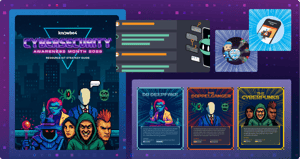 AI and AI-generated deepfakes are proving to be the most intriguing, and in some ways troubling, recent advances in technology.
AI and AI-generated deepfakes are proving to be the most intriguing, and in some ways troubling, recent advances in technology.
No wonder one of my favorite characters from “The Inside Man” series, AJ, is so enthralled by them.AJ is a friendly, funny, unstoppable security dynamo with a deep love of all things tech.
But as AJ learns through his journey in the events of “The Inside Man,” AI can have a dark side.
There have been few technological advancements that have shaped the world the way AI is shaping it currently. AI’s impact is on par with the creation of the internet. Unfortunately, along with the people who use it for good things, comes those who misuse it.
Not only has AI changed how we do research and generate images, it is also being used to streamline workflows. Because AI never gets tired after staring at a screen too long, it is a great tool for sifting through large amounts of data. This is where AI greatly assists cybercriminals in accomplishing their dastardly deeds..
Information Harvesting
By merely interacting with most technology these days, we generate a tremendous amount of digital data. While this information may seem somewhat harmless, it’s possible to build a detailed profile based on that data. If a target of a scammer visits the same gym at the same time every week, bad actors know the pattern and can use that against them, for example, to plan a “random” introduction that will end in a scam.
All of this data lost in recent data breaches can become a serious issue for us. Earlier this year, over 10 billion username and password pairs were released as part of something called RockYou2024. This staggering amount of information would be difficult for a typical person to try to make use of. For AI however, it won't take much to organize this information for criminals. AI could even develop a scenario that could be individualized based on where the username and password came from.
Deepfakes
Many of us have heard of AI-created deepfakes. Currently, the ability to generate deepfakes in real time is unrealistic, however they have been used to dupe organizations such as in a fake Zoom call, costing an organization $25 million. The future of social engineering will change as deepfakes continue to evolve. Digital impersonations will become much more common in high value industries that deal with finance, healthcare, or significant amounts of valuable intellectual property.
Defending against the threat
While AI will pose us challenges, all is not lost. Through education of ourselves, our families and our employees, we can avoid falling victim to scams or cyber attacks that are using AI. Organizations should adopt policies to counter potential attacks, such as requiring a second form of confirmation before large amounts of money are transferred, or significant amounts of sensitive information are sent to someone. In the battle against social engineering, education really is the best defense.






